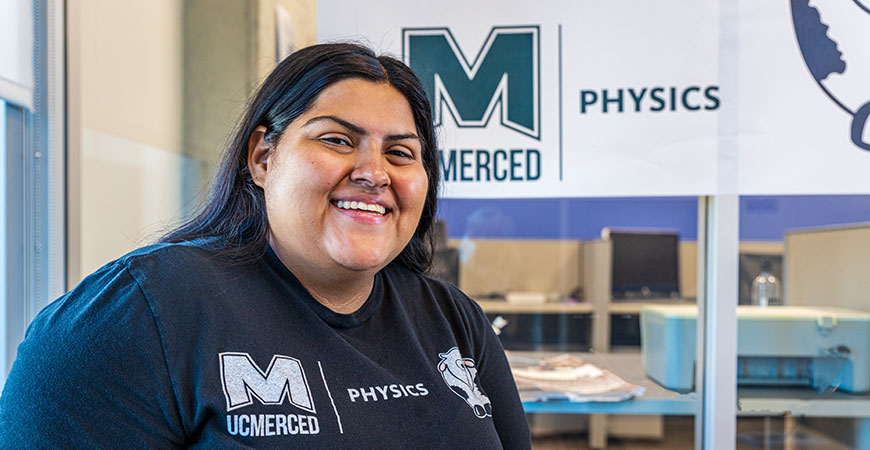
Big-wave surfing is a thing these days, but hardly anyone is riding a wave as big as the one Biviana Oseguera is on.
The physics major is studying the 9,000-light-year long Radcliffe Wave, a structure made of clouds of dust and young stars that form a wave-like structure through the Milky Way.
So far, it is the largest structure of interacting nebulae described.
The rising senior recently won the Chambliss Astronomy Achievement Award, one of only two awarded to undergraduates at the American Astronomical Society meeting.
 The Merced native knew early on that she wanted to be a scientist, in part because her oldest brother was interested in science and she wanted to be like him, and in part because her parents made sure that she and her three brothers always had science kits to experiment with.
The Merced native knew early on that she wanted to be a scientist, in part because her oldest brother was interested in science and she wanted to be like him, and in part because her parents made sure that she and her three brothers always had science kits to experiment with.
But in fifth grade, one of her teachers was giving out free books and she picked up a book on the moon, one on the solar system and a book on Mars, and she was hooked.
“I asked him what kind of science it was, and a little further along he explained that it was physics and I thought, ‘That's what I want to do,’” she said. “Throughout school, my interest just kept growing.”
When she got to UC Merced, she planned to take any astrophysics courses that were offered just because of her interest. She didn't know what area of astrophysics she wanted to focus on, but now that has changed.
Oseguera was supposed to graduate this past spring, but she wanted to make sure she had time to do substantial research before she graduated. She reached out to astrophysics Professor Sarah Loebman, who turned her on to the Radcliffe Wave and became her advisor.
“She sent me a YouTube link and I looked at it and said, ‘This is awesome,’” Oseguera said. “This massive thing is in space. I was very interested.”
The wave was discovered in 2020 by researchers at Radcliffe Institute for Advanced Study at Harvard University. The structure was previously thought to be a 3,000-light-year wide structure in the shape of an incomplete ring around the galaxy, named Gould’s Belt. It is actually 400 light years wide and that crests and troughs 500 light years above and below the galactic plane. As they were trying to create a more accurate 3D map of the interstellar clouds within 7,000 light years of the sun, the Radcliffe researchers saw what they had not been able to see in two dimensions.
The wave forms an oscillating pattern that peaks about 500 light years both above and below the galaxy’s central disc. According to Harvard magazine, the wave holds about 3 million times the mass of the sun, mostly in clouds of dust and gas. Scientists have never seen clouds organized in this way, but the Harvard researchers believe this is the backbone of the Orion Arm, the spiral arm of the Milky Way where our sun lives.
Researchers don't know what causes the pattern.
Oseguera is working with simulated galaxies that are like the Milky Way to see if she can figure out what features cause the wave and how common it is to find.
“I want to go through the galaxies and see if I can find any other similar structures, find the common properties and backtrack to find the cause,” she said. “Is the wave only found in spiral galaxies? Could it be a supernova explosion or another galaxy coming close to ours?”
Oseguera had thought she wanted to teach middle school or high school until she began to do her own research and fell in love with it. Now she wants to be a faculty member at the university.
Apparently, her passion was obvious to the audiences at the American Astronomical Society meeting in Albuquerque, attended by thousands of astronomers, students, educators and journalists.
Loebman said she had intended to go ask Oseguera some questions about her poster, but “she was swamped. She constantly had groups of people around her research poster, listening to her presentation and having these long, active discussions with her.” Oseguera said she gave her presentation at least six times that day during the hour-long timeslot.
“Each presenter gets evaluated by multiple reviewers,” Loebman said. “Her science was compelling, and she was open and inviting, and she had really nice animations to help explain the concept to people. I'm very proud of her.”



